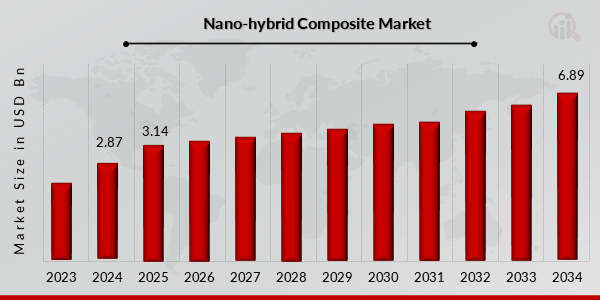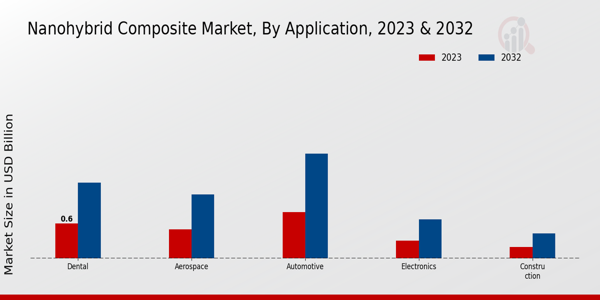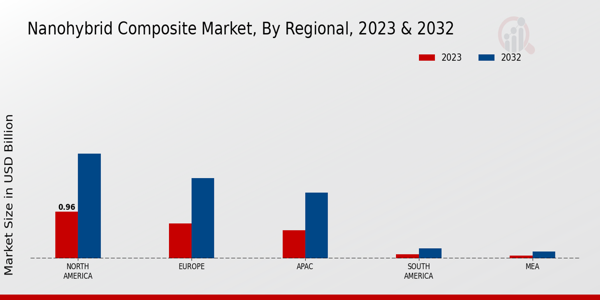Global Nano-hybrid Composite Market Overview
The Nano Hybrid Composite Market Size was estimated at 2.87 (USD Billion) in 2024. Nano Hybrid Composite Industry is expected to grow from 3.14 (USD Billion) in 2025 to 6.89 (USD Billion) by 2034, at a CAGR (growth rate) is expected to be around 9.10% during the forecast period (2025 - 2034)
Key Nano-hybrid Composite Market Trends Highlighted
The Nano-hybrid Composite Market is witnessing significant growth driven by the increasing demand for lightweight, durable materials across various industries such as automotive, aerospace, and consumer goods. The integration of nanotechnology into composite materials enhances their mechanical properties and thermal stability, making them more appealing for manufacturers looking to improve product performance while reducing weight. Environmental concerns are also fueling interest in these materials, as they can lead to more efficient energy use and a reduction in carbon emissions.
Key opportunities lie in the expanding applications of nanohybrid composites in fields such as electronics, medical devices, and construction.As industries seek innovative solutions for better product functionality, the versatility of these composites offers a pathway for development. For instance, advancements in nanomaterials such as carbon nanotubes and graphene-based composites present new possibilities for creating stronger and more efficient products. Furthermore, ongoing research and development efforts aimed at improving the properties of these materials will likely uncover new applications and markets. Recent trends highlight a growing emphasis on sustainability in the production and application of nanohybrid composites.
Companies are increasingly focusing on developing eco-friendly composites that not only meet performance standards but also adhere to environmental regulations.Moreover, advancements in manufacturing technologies, such as additive manufacturing, are enabling more precise and cost-effective production processes. The use of nanohybrid composites is becoming more prevalent as industries recognize their potential to revolutionize traditional material applications, making them an integral part of future innovations.

Source: Primary Research, Secondary Research, Market Research Future Database and Analyst Review
Nano-hybrid Composite Market Drivers
Increasing Demand for Lightweight Materials
The growing preference for lightweight materials extends across various industries, including automotive, aerospace, and consumer goods. This shift is largely driven by the need for enhanced fuel efficiency and reduced energy consumption. The Nano-hybrid Composite Market Industry is experiencing significant growth as manufacturers seek to replace traditional materials with nanohybrid composites, which offer superior strength-to-weight ratios and enhanced performance characteristics.As environmental regulations become stricter and consumer awareness regarding sustainability increases, the demand for lightweight materials is projected to rise.
This is expected to push the development and adoption of nanohybrid composites, allowing industries to innovate while meeting stringent performance and sustainability criteria. Additionally, the versatility of these materials enables their application in a wide range of products, from automotive parts to sporting equipment, thereby broadening their market appeal.Attached to this trend is the pursuit of high-performance materials that can withstand extreme conditions without compromising on weight, which positions nanohybrid composites as a prime choice for manufacturers.
Their ability to integrate properties such as thermal resistance, electrical conductivity, and enhanced durability further strengthens their role in meeting current and future market demands.
Advancements in Material Science and Technology
Rapid advancements in material science and technology are revamping the Nano-hybrid Composite Market Industry. The ongoing research and development in nanotechnology have paved the way for innovative composite materials that exhibit remarkable properties. These advancements enable manufacturers to create composites with tailored characteristics, leading to higher performance and better application in various sectors such as electronics, construction, and medical devices.Enhanced manufacturing processes and techniques are expanding the potential uses of nanohybrid composites, driving their acceptance and integration into new applications.
As companies continue to invest in R&D, technological improvements are likely to foster a competitive edge in the market, attracting more players and stimulating market growth.
Growing Eco-Friendly Initiatives
The rising concern for environmental sustainability is propelling the demand for eco-friendly materials, including nanohybrid composites. As industries aim to reduce their carbon footprint, they are progressively shifting towards materials that are recyclable and less harmful to the environment. Nanohybrid composites, known for their durability and the potential for sustainable sourcing, fit well into this eco-friendly narrative.
They can significantly cut down on waste and energy required during their lifecycle, which aligns with the growing initiatives towards sustainable practices.This trend is enhancing the growth prospects of the Nano-hybrid Composite Market Industry as more organizations seek to comply with environmental standards and attract environmentally conscious consumers.
Nano-hybrid Composite Market Segment Insights
Nano-hybrid Composite Market Application Insights
The Nano-hybrid Composite Market is anticipated to experience notable growth across various applications, reflecting a strong demand in multiple industries. In 2023, the overall market was valued at 2.41 USD Billion, showcasing its expansive scope. The application of nanohybrid composites within different sectors such as Dental, Aerospace, Automotive, Electronics, and Construction has marked significant traction, driven primarily by their unique properties including high strength, lightweight nature, and versatility.
The dental application, valued at 0.6 USD Billion in 2023, is crucial due to the increasing focus on aesthetic dentistry and dental restoration solutions. This segment is expected to grow substantially, indicating a robust interest in dental innovations.
Meanwhile, the aerospace application, valued at 0.5 USD Billion, plays an essential role in reducing the weight of aircraft while maintaining strength, thus enhancing fuel efficiency and operational costs. The automotive sector holds a commanding position with a valuation of 0.8 USD Billion due to the push towards lightweight materials that improve fuel efficiency and sustainability in vehicle design.
The electronics sector, while smaller at 0.31 USD Billion in 2023, is significant in terms of evolving technological advancement where nanohybrid composites are integrated into electronic components to improve performance and functionality. Construction, although the smallest application segment valued at 0.2 USD Billion, is gaining ground by using these materials for enhanced durability and structural integrity in building projects.
Each of these areas contributes to the market growth and diversification of the Nano-hybrid Composite Market revenue, with industries seeking innovative solutions to meet demanding performance criteria. Market growth is further amplified by rising trends in sustainability and eco-friendly materials that align with regulatory standards and consumer expectations. Challenges remain, notably in terms of production costs and the need for technological advancements to scale applications. However, opportunities abound as sectors push for higher durability and performance from their materials, with nanohybrid composites poised to meet these demands effectively, cementing their role across various applications in the years to come.

Source: Primary Research, Secondary Research, Market Research Future Database and Analyst Review
Nano-hybrid Composite Market Type Insights
The Nano-hybrid Composite Market is poised for substantial growth, with a projected valuation of 2.41 billion USD in 2023 and an expected increase to 5.3 billion USD by 2032. Within this market, the Type segment offers valuable insights into the various materials utilized, including Fillers, Matrix Materials, and Reinforcement Materials. Fillers play a crucial role in enhancing the mechanical properties and thermal stability of nanohybrid composites, a crucial factor for applications in industries such as automotive and aerospace.
Matrix Materials are significant as they form the base that binds the other components together, providing structural integrity and facilitating load transfer.Reinforcement Materials dominate this segment due to their ability to significantly improve strength and durability, making them indispensable in high-performance applications. The combined market growth is driven by the increasing demand for lightweight, high-strength materials across various industries, while challenges may arise from material sourcing and manufacturing processes. Moreover, there are ample opportunities for innovation, particularly in developing sustainable and eco-friendly composite solutions.
The overall Nano-hybrid Composite Market data reflects a promising upward trajectory with consistent advancements and expansion within the industry.
Nano-hybrid Composite Market End-Use Insights
The Nano-hybrid Composite Market, valued at 2.41 USD Billion in 2023, shows robust development across its End Use segment, notably within the Medical Devices, Consumer Goods, Industrial Applications, and Defense sectors. Each of these sectors is experiencing growth fueled by advancements in technology and material science. Medical Devices, for example, leverage nanohybrid composites for enhanced biocompatibility and durability, which is crucial for improving patient outcomes.
In the Consumer Goods sector, the appeal lies in the improved performance and aesthetic qualities provided by these materials, thereby attracting manufacturers seeking competitive advantages.Industrial Applications are increasingly incorporating nanohybrid composites to enhance efficiency, strength, and resilience in manufacturing processes. The Defense industry also recognizes significant benefits, utilizing these composites to create lightweight, durable materials essential for advanced military equipment. The diverse applications and advantages across various industries contribute to the overall growth of the Nano-hybrid Composite Market, further emphasizing the relevance of its segmentation in addressing market needs and consumer demands.
Nano-hybrid Composite Market Composition Insights
The Nano-hybrid Composite Market, with an estimated valuation of 2.41 USD billion in 2023, has shown significant growth potential, particularly within its Composition segment. This segment features various materials such as Ceramic-Based, Polymer-Based, and Metal-Based composites, each contributing uniquely to the market landscape. Ceramic-based composites are recognized for their superior mechanical properties, making them a popular choice in various industrial applications.
On the other hand, Polymer-Based composites dominate the market due to their lightweight characteristics and high resistance to corrosion, making them ideal for automotive and aerospace applications.Meanwhile, Metal-Based composites offer excellent thermal and electrical conductivity, serving essential roles in electronics and thermal management solutions. As demand rises across multiple sectors, including construction, automotive, and healthcare, the Nano-hybrid Composite Market revenue is projected to reach 5.3 USD billion by 2032, fuelled by increasing innovation and diverse application arenas. Despite the growth prospects, challenges such as raw material availability and manufacturing costs may impact the market's development.
Nevertheless, the opportunities presented by technological advancements and the rising demand for lightweight and high-strength materials continue to drive market expansion.
Nano-hybrid Composite Market Regional Insights
The Nano-hybrid Composite Market is experiencing notable growth across various regions, with an overall valuation of 2.41 USD Billion in 2023, projected to reach 5.3 USD Billion by 2032, showcasing a robust growth trajectory. North America held a majority share, valued at 0.96 USD Billion in 2023, and is expected to grow to 2.15 USD Billion by 2032, reflecting its significant demand and advancements in technology.
Europe follows closely, with a valuation of 0.72 USD Billion in 2023, rising to 1.65 USD Billion in 2032, indicating its strong manufacturing base and innovation in composite materials.The Asia-Pacific (APAC) region, valued at 0.58 USD Billion in 2023 and projected to reach 1.35 USD Billion in 2032, shows promising growth driven by increasing industrial applications and consumer electronics demand. South America, while smaller, is valued at 0.09 USD Billion in 2023 and is expected to grow to 0.21 USD Billion by 2032, reflecting emerging market opportunities.
The Middle East and Africa (MEA) market is currently the least valued at 0.06 USD Billion in 2023 but is anticipated to grow to 0.14 USD Billion by 2032, highlighting the potential for future expansion in this region.Overall, the Nano-hybrid Composite Market segmentation reveals varying degrees of growth and potential, with North America and Europe currently dominating in value and innovation, while the other regions hold opportunities for development driven by technological advancements and increasing applications.

Source: Primary Research, Secondary Research, Market Research Future Database and Analyst Review
Nano-hybrid Composite Market Key Players and Competitive Insights
The Nano-hybrid Composite Market has exhibited significant growth driven by the increasing demand for lightweight, high-performance materials across various industries, including automotive, electronics, and healthcare. Key players in the market are continually innovating to enhance product functionalities, focusing on developing composites that contribute to improved mechanical strength, thermal stability, and electrical conductivity. The competitive landscape is marked by a mix of established companies and emerging players, each vying to capture market share through advanced technology, strategic collaborations, and comprehensive research and development efforts.
As sustainability becomes a pivotal concern, firms are also integrating eco-friendly practices in their manufacturing processes, further shaping the competitive dynamics of the nanohybrid composite sector.Royal DSM has established a strong presence in the Nano-hybrid Composite Market, leveraging its extensive expertise in materials science and its commitment to sustainability. The company is renowned for its innovative solutions that cater to various industry needs. With a robust portfolio of products that include high-performance thermoplastics and composites, Royal DSM excels in providing materials that satisfy technical specifications while also addressing environmental considerations.
The company's ability to integrate advanced technology into its manufacturing processes allows it to produce highly engineered nanohybrid composites that meet stringent performance requirements. Additionally, Royal DSM's strategic partnerships and collaborations with academic institutions and industry leaders further enhance its competitive edge, enabling the company to stay ahead in research and product development.Nanocyl has made significant strides in the Nano-hybrid Composite Market by focusing on the production of carbon nanomaterials and their application in enhancing composite materials.
Known for its high-quality carbon nanotubes, Nanocyl has carved a niche in developing advanced nanohybrid composites that possess superior mechanical, thermal, and electrical properties. The company's dedication to innovation is evident in its continuous research efforts aimed at optimizing the performance of its products across various sectors, including automotive, aerospace, and electronics. By committing to excellence in production techniques and maintaining a robust supply chain, Nanocyl has positioned itself as a pivotal player in the market.
The company's emphasis on high-performance solutions, coupled with its proactive customer engagement and tailored product offerings, enables it to meet the diverse demands of a rapidly evolving market landscape.
Key Companies in the Nano-hybrid Composite Market Include
- Uniroyal Engineered Products
- Momentive Performance Materials
Nano-hybrid Composite Market Industry Developments
Recent developments in the Nano-hybrid Composite Market indicate significant advancements and investments by key players such as Royal DSM, Nanocyl, Mitsubishi Chemical, and Evonik Industries. These companies are increasingly focusing on innovative applications of nanohybrid composites in automotive, aerospace, and electronics, driving growth in this sector. Additionally, 3M and Huntsman have been enhancing their product portfolio through strategic collaborations and research initiatives aimed at improving the performance characteristics of nanohybrid materials.
There have also been notable mergers and acquisitions, particularly with companies like DuPont and BASF, which are consolidating their positions in the market to leverage synergies and expand their technological capabilities. AkzoNobel is actively pursuing collaborations to enhance its presence in sustainable nanocomposite solutions, while Covestro's recent investments in production capacity reflect the rising demand for advanced materials. The overall market valuation is expected to see significant growth, influenced by increasing demand across various industries and the ongoing trend of material innovation.
As companies focus on sustainability and advanced material properties, the competitive landscape in the Nano-hybrid Composite Market is becoming increasingly dynamic and evolving.
Nano-hybrid Composite Market Segmentation Insights
Nano-hybrid Composite Market Application Outlook
Nano-hybrid Composite Market Type Outlook
Nano-hybrid Composite Market End-Use Outlook
Nano-hybrid Composite Market Composition Outlook
Nano-hybrid Composite Market Regional Outlook
|
Report Attribute/Metric
|
Details
|
|
Market Size 2024
|
2.87 (USD Billion)
|
|
Market Size 2025
|
3.14 (USD Billion)
|
|
Market Size 2034
|
6.89 (USD Billion)
|
|
Compound Annual Growth Rate (CAGR)
|
9.10% (2025 - 2034)
|
|
Report Coverage
|
Revenue Forecast, Competitive Landscape, Growth Factors, and Trends
|
|
Base Year
|
2024
|
|
Market Forecast Period
|
2025 - 2034
|
|
Historical Data
|
2020 - 2024
|
| Market Forecast Units |
USD Billion |
| Key Companies Profiled |
Royal DSM, Nanocyl, Uniroyal Engineered Products, Mitsubishi Chemical, 3M, Huntsman, Momentive Performance Materials, Evonik Industries, Avery Dennison, AkzoNobel, BASF, Kraton Corporation, SABIC, DuPont, Covestro |
| Segments Covered |
Application, Type, End Use, Composition, Regional |
| Key Market Opportunities |
Increased demand in the automotive industry, Growth in renewable energy applications, Rising popularity in the electronics sector, Advancements in construction materials, Expanding use in medical devices |
| Key Market Dynamics |
Increasing demand for lightweight materials, Growing applications in the automotive industry, Advancements in nanotechnology, Rising awareness of sustainability, Expanding use in the aerospace sector |
| Countries Covered |
North America, Europe, APAC, South America, MEA |
Frequently Asked Questions (FAQ):
The Nano-hybrid Composite Market is expected to be valued at 6.89 USD Billion by 2034.
The expected CAGR for the Nano-hybrid Composite Market is 9.10% from 2025 to 2034.
North America is projected to have the largest market share, valued at 2.15 USD Billion by 2032.
The Automotive application segment is projected to be valued at 1.8 USD Billion by 2032.
Key players in the market include Royal DSM, Nanocyl, Uniroyal Engineered Products, and 3M, among others.
The Dental application segment is projected to reach a market size of 1.3 USD Billion by 2032.
The Electronics application segment is expected to grow to 0.67 USD Billion by 2032.
The expected market value for the South American region is projected to be 0.21 USD Billion by 2032.
The Aerospace application segment is expected to be valued at 1.1 USD Billion by 2032.
The construction application segment is projected to reach a market size of 0.43 USD Billion by 2032.
















